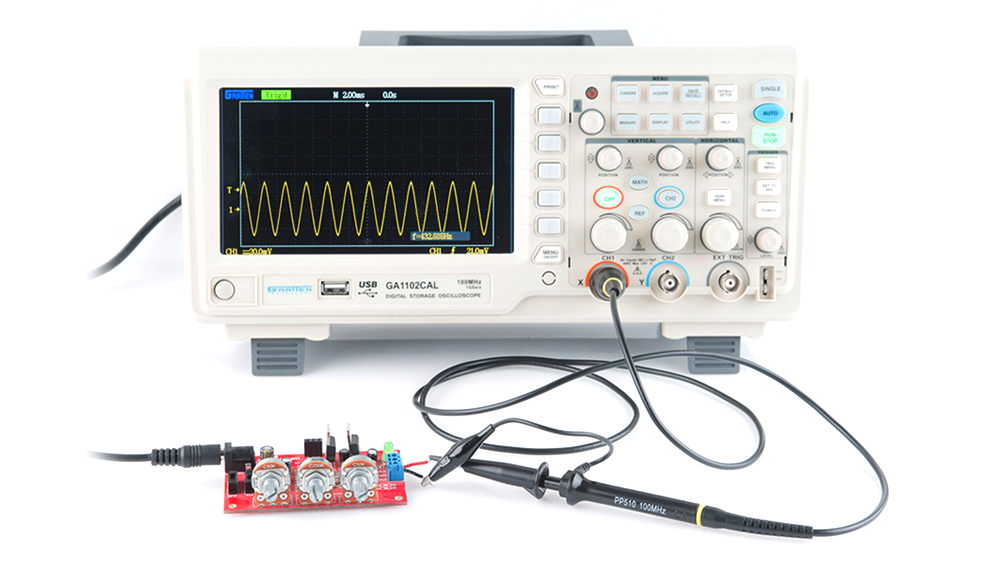Table of Contents
- Determine what you need – use the 'five times rule'
- Determine what you need
- Passive probes
- High-voltage differential probesLogic probes
- Current Probes
- Determine what you need
An oscilloscope, often known as an oscillograph or scope meter, is a tabletop instrument that displays electrical signals visually and shows how they change over time. Engineers use them to debug circuits and test signal quality. Waveforms are acquired and stored by digital oscilloscopes, which show the voltage, frequency, noise content, distorted signal, signal timing, and other information about a signal.
But how do you know which oscilloscope is ideal for your application when choosing the finest oscilloscope? When purchasing an oscilloscope, there are ten significant aspects to consider. Continue reading to learn how to select an oscilloscope for your application.
Oscilloscope bandwidth
The system bandwidth of an oscilloscope determines its ability to measure a signal. It determines the instrument's maximum frequency at which it may be accurately monitored. Bandwidth is also a significant price determinant.![]()
Determine what you need – use the 'five times rule'
A 100 MHz oscilloscope, for example, is usually guaranteed to have less than 30% attenuation at 100 MHz. Inputs should be less than 20 MHz to ensure amplitude accuracy of better than 2%. Measuring the rise and fall times of digital signals is crucial. The lowest rise-time that an oscilloscope can measure is determined by bandwidth and sample rate.
A measurement system with bandwidth is formed by the probe and oscilloscope. If you use a low-bandwidth probe, the overall bandwidth will be reduced; thus, make sure you use probes that are corresponding to the scope.
Oscilloscope rise time![]()
The useable frequency range is described by the rise time, a crucial measurement in the digital age. When measuring digital signals like pulses and stages, the rise time is frequently considered.
An oscilloscope must have enough rise time to accurately catch the details of quick transitions. For accurate time measurements, a sharp rise time is also required. Use the following equation to determine the oscilloscope rise time needed for your signal type:![]()
A scope with a quicker than 800 ps rise time, for example, is required for a 4-ns rise time. Note that, like bandwidth, this rule of thumb may not always be practicable to follow. The rising times (edge speeds) of several logic families are faster than their clock rates suggest. Signals with rising times like those of an 800 MHz CPU may exist in a processor with a 20 MHz clock. When analyzing square waves and pulses, rise times are crucial.
Oscilloscope sample rate![]()
An oscilloscope's sample rate is similar to a movie camera's frame rate. It determines how much waveform detail can be captured by the scope. The sampling rate of an oscilloscope is measured in samples per second (S/s). A 'five times rule' is recommended once more. Use a sampling rate that is at least 5 times the highest frequency component in your circuit.
Oscilloscopes are available at various sample rates, ranging from 1 to 200 GS/s, to meet your application's requirements. The less information you lose by sampling quickly, the better the scope will represent the signal under test. Fast selection, on the other hand, quickly fills up your memory, limiting the amount of time you can capture.
Channel density of an oscilloscope
Analog channels are sampled by digital oscilloscopes to store and show them. The more channels, in general, the better, albeit additional channels increase the price.
Determine what you need![]()
Whether you require an oscilloscope with two, four, six, or even eight analog channels depends on your application. Two channels, for example, allow you to compare the input and output of a component. Four analog channels will enable you to reach more signals and provide you additional options for mathematically combining media (multiplying to get power, or subtracting for differential signals, for example). In a power-related setting, oscilloscopes with six or eight channels allow multiple bus analyses while simultaneously examining voltage or current type data.
A Mixed Signal Oscilloscope has digital timing channels that show high and low states and can be presented as a bus waveform. Whatever channel you choose, it should have good range, linearity, gain accuracy, flatness, and static discharge resistance.
To save money, specific instruments share the sampling system between channels. However, be aware that increasing the number of channels can limit the sampling rate.
Consider compatible oscilloscope probes
The probe tip is the starting point for correct measurements. When choosing an oscilloscope, keep in mind that the scope and probe function together as a system.
Probes become a part of the circuit when taking measurements, announcing resistive, capacitive, and inductive loading that changes the measurement. It's recommended to utilize probes made precisely for your scope to reduce the effect.
Choose passive probes with an adequate bandwidth. The bandwidth of the probe should match that of the oscilloscope.
You'll be able to utilize your scope in more applications if you have a wide selection of suitable probes.![]()
Passive probes
Probes with a 10X attenuation provide your circuit with controlled impedance and capacitance, making them ideal for most ground-referenced measurements. Most oscilloscopes come with these; you'll need one for each input channel.
High-voltage differential probes
A ground-referenced oscilloscope can use differential probes to obtain safe, accurate floating and differential measurements. At the very least, every lab should have one.
Logic probes
Digital signals are sent to the front end of a Mixed Signal Oscilloscope using logic probes. They come with "flying leads" and accessories for connecting to small test spots on a circuit board.
Current Probes
The addition of a current probe allows the scope to measure current and calculate and display instantaneous power.
Triggering capabilities of an oscilloscope
Edge triggering is available on all oscilloscopes, while pulse width triggering









 Calibration
Calibration
 HVAC/Clean Rooms
HVAC/Clean Rooms
 Electrical
Electrical
 Power & Energy
Power & Energy
 Mechanical & Maintenance
Mechanical & Maintenance
 Pharma, Health & Biomedical
Pharma, Health & Biomedical
 Drone Solution
Drone Solution
 Networking
Networking
 Transformer & Relay Testing
Transformer & Relay Testing
 Insulation, Resistance and Battery
Insulation, Resistance and Battery
 Fault Testing & Diagnostics
Fault Testing & Diagnostics
 Lightning Protection Solution
Lightning Protection Solution
 Education, Research & Development
Education, Research & Development
 Civil Equipment
Civil Equipment
 Renewable Energy
Renewable Energy
 Cleaning and supplies
Cleaning and supplies
 Power Tools
Power Tools
 Safety Tools
Safety Tools
 Hardwares
Hardwares
 Construction Supply
Construction Supply
 Stationeries
Stationeries
 Garden Tools
Garden Tools
 Accessories
Accessories
 Machines
Machines
 Hand Tools
Hand Tools